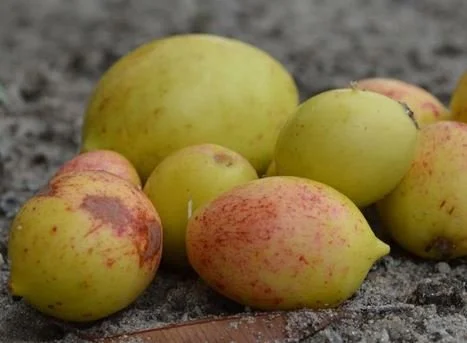Hancornia Speciosa - Mangaba
Seeds were imported from Brazil. A lesser known fruit of the dry forest regions of Brazil, the Mangaba is a round, green-yellow-orange fruit with lovely, sweet and aromatic pulp. The fruits are typically used when soft and very ripe, and are cultivated commercially on a small scale in parts of its home range. Deciduous, shrubby tree to 20-25 ft. / 7-8 m. Unknown frost tolerance. The fruit needs to be very ripe and soft (fallen to the ground) to be free of any latex or bitterness. Fully ripe fruits have a delicious, succulent, viscous, sweet, aromatic pulp. A pleasant sub-acid flavor. The fruit can also be made into a juice, sherbet, preserves etc. It is much esteemed as a marmalade in parts of Brazil. The fruit is 3 - 6cm in diameter. It is found mainly in the Northeastern regions of Brazil. Northeast Brazil has a warm, tropical climate that varies across its vast landscape. Coastal areas enjoy high humidity, steady warmth, and frequent rainfall, particularly from March to August, with average temperatures around 77–86°F (25–30°C). Northeast Brazil's climate is similar to USDA Hardiness Zones 10-13 in the United States. Coastal areas with steady warmth and humidity align with zones in southern Florida and Hawaii, where tropical plants thrive. Seeds will be shipped in vermiculite.
Seeds were imported from Brazil. A lesser known fruit of the dry forest regions of Brazil, the Mangaba is a round, green-yellow-orange fruit with lovely, sweet and aromatic pulp. The fruits are typically used when soft and very ripe, and are cultivated commercially on a small scale in parts of its home range. Deciduous, shrubby tree to 20-25 ft. / 7-8 m. Unknown frost tolerance. The fruit needs to be very ripe and soft (fallen to the ground) to be free of any latex or bitterness. Fully ripe fruits have a delicious, succulent, viscous, sweet, aromatic pulp. A pleasant sub-acid flavor. The fruit can also be made into a juice, sherbet, preserves etc. It is much esteemed as a marmalade in parts of Brazil. The fruit is 3 - 6cm in diameter. It is found mainly in the Northeastern regions of Brazil. Northeast Brazil has a warm, tropical climate that varies across its vast landscape. Coastal areas enjoy high humidity, steady warmth, and frequent rainfall, particularly from March to August, with average temperatures around 77–86°F (25–30°C). Northeast Brazil's climate is similar to USDA Hardiness Zones 10-13 in the United States. Coastal areas with steady warmth and humidity align with zones in southern Florida and Hawaii, where tropical plants thrive. Seeds will be shipped in vermiculite.
Seeds were imported from Brazil. A lesser known fruit of the dry forest regions of Brazil, the Mangaba is a round, green-yellow-orange fruit with lovely, sweet and aromatic pulp. The fruits are typically used when soft and very ripe, and are cultivated commercially on a small scale in parts of its home range. Deciduous, shrubby tree to 20-25 ft. / 7-8 m. Unknown frost tolerance. The fruit needs to be very ripe and soft (fallen to the ground) to be free of any latex or bitterness. Fully ripe fruits have a delicious, succulent, viscous, sweet, aromatic pulp. A pleasant sub-acid flavor. The fruit can also be made into a juice, sherbet, preserves etc. It is much esteemed as a marmalade in parts of Brazil. The fruit is 3 - 6cm in diameter. It is found mainly in the Northeastern regions of Brazil. Northeast Brazil has a warm, tropical climate that varies across its vast landscape. Coastal areas enjoy high humidity, steady warmth, and frequent rainfall, particularly from March to August, with average temperatures around 77–86°F (25–30°C). Northeast Brazil's climate is similar to USDA Hardiness Zones 10-13 in the United States. Coastal areas with steady warmth and humidity align with zones in southern Florida and Hawaii, where tropical plants thrive. Seeds will be shipped in vermiculite.




